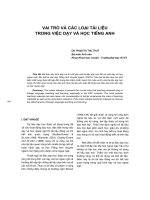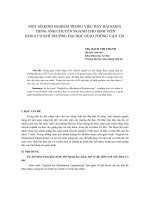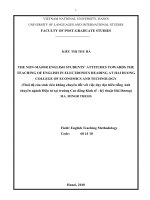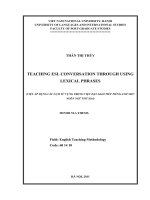Teaching ESL conversation through using lexical phrases = Việc áp dụng các cụm từ vựng trong việc dạy giao tiếp Tiếng Anh như ngôn ngữ thứ hai tt.PDF
Bạn đang xem bản rút gọn của tài liệu. Xem và tải ngay bản đầy đủ của tài liệu tại đây (562.27 KB, 14 trang )
VIET NAM NATIONAL UNIVERSITY, HANOI
UNIVERSITY OF LANGUAGES AND INTERNATIONAL STUDIES
FACULTY OF POST-GRADUATE STUDIES
****************************************
THÂN THỊ THÚY
TEACHING ESL CONVERSATION THROUGH USING
LEXICAL PHRASES
(VIỆC ÁP DỤNG CÁC CỤM TỪ VỰNG TRONG VIỆC DẠY GIAO TIẾP TIẾNG ANH NHƯ
NGÔN NGỮ THỨ HAI)
MINOR M.A THESIS
Field: English Teaching Methodology
Code: 60 14 10
H NI, 2011
VIET NAM NATIONAL UNIVERSITY, HANOI
UNIVERSITY OF LANGUAGES AND INTERNATIONAL STUDIES
FACULTY OF POST-GRADUATE STUDIES
****************************************
THÂN THỊ THÚY
TEACHING ESL CONVERSATION THROUGH USING
LEXICAL PHRASES
(VIỆC ÁP DỤNG CÁC CỤM TỪ VỰNG TRONG VIỆC DẠY GIAO TIẾP TIẾNG ANH NHƯ
NGÔN NGỮ THỨ HAI)
MINOR M.A THESIS
Field: English Teaching Methodology
Code: 60 14 10
Supervisor: PHAN VÂN QUYÊN, M.A
H NI, 2011
v
TABLE OF CONTENTS
Certificate of originality i
Retention and use of the thesis ii
Acknowledgements iii
Abstract iv
Table of contents v
List of tables vii
List of figures viii
PART ONE: INTRODUCTION 1
1 Rationale of the study 1
2 Aim of the study 2
3 Research questions 2
4 Scope and limitations of the study 3
5 Significance of the study 3
6 Design of the study 3
PART TWO: THE STUDY 5
Chapter 1 Literature review 5
1.1 Lexical phrases 5
1.1.1 Review of lexical phrases 5
1.1.2 Definition of lexical phrases 5
1.1.3 Kinds of lexical phrases 6
1.2 What is communication? 7
1.2.1 Definitions and roles of communication 7
1.2.2 Characteristics of conversation 8
1.2.2.1 Conversation is lexis-centered not grammar-centered 8
1.2.2.2 Intonation phrases are very popular in spoken English 10
1.2.2.3 Language of conversation is vague 10
1.2.3 Spoken English: fluency or accuracy? 11
1.2.4 The “I- centric” in communication 12
vi
1.3 Lexical phrases and communication 12
1.3.1 Lexical phrases and communicative competence 12
1.3.2 Lexical phrases and conversation 15
1.3.3 Lexical phrases and oral fluency 17
1.4 Summary 19
Chapter 2 Methodology 20
2.1 Research questions 20
2.2 Subjects and data collection instruments 20
2.2.1 Subjects 20
2.2.2 Data collection instruments 22
2.2.2.1 Questionnaire for the students 23
2.2.2.2 Questionnaire for the teachers 24
2.3 Data collection procedures 24
2.4 Research method 25
2.5 Summary 25
Chapter 3 Data analysis and findings 26
3.1 Learners’ responses to the questionnaires 26
3.2 Teachers’ responses to the questionnaires 36
3.3 Major findings and discussions 42
3.4 Summary 42
PART THREE CONCLUSIONS 43
1 Conclusions 43
2 Implications 43
3 Suggestions for further study 43
BIBLIOGRAPHY 45
APPENDIX 1: STUDENTS’ QUESTIONANNAIRE (in Vietnamese) I
APPENDIX 2: STUDENTS’ QUESTIONANNAIRE (in English) IV
APPENDIX 3: TEACHERS’ QUESTIONANNAIRE (in Vietnamese) VII
APPENDIX 4: TEACHERS’ QUESTIONANNAIRE (in English) IX
1
TEACHING ESL CONVERSATION THROUGH USING LEXICAL PHRASES
PART ONE: INTRODUCTION
1. Rationale
- Although research into the application of lexical phrases in spoken English has been
widely implemented through out the world, it is still somehow a strange concept in
Vietnamese context of teaching and learning spoken English.
- The speaking skill is the most important skill in the four skills since we can not
successfully teach out students a language if they can write well but somehow fail to speak
that language.
- I also want to find out something meaningful that can help students speak English more
fluently and naturally.
2. Aims of the study
This study was carried out in order to:
- Give some theoretical information about the nature of spoken English.
- Find out teachers and students‟ habits of learning spoken English as well as their
opinions on the roles of lexical phrases in spoken English.
- Provide some suggestions to the teaching and learning of spoken English.
3. Research questions
1. What are the habits of teaching and learning spoken English of teachers and
students at HUI?
2. What do teachers and students think about the roles of lexical phrases in spoken
English?
4. Research methodology
The quantitative method was applied with two questionnaires designed to collect data for
the study.
5. Scope of the study
- The study is conducted just to collect the subjects‟ points of view of the relationship
between lexical phrases and spoken English
- The lexical phrases are mainly from the book “Lexical phrases and language teaching”
by Nattinger & DeCarrico (1992).
6. Design of the study
The study consists of 3 main parts:
2
Part One is the introduction providing background information to the study. This chapter
provides the rationale, the aim, research questions, the scope and limitations, the
significance of the study.
Part Two is the study. This part consists of 3 chapters:
-Chapter one: Literature review: this chapter provides the relevant literature in which the
theoretical background is mentioned to see the important roles of lexical phrases in
teaching and learning spoken English.
-Chapter Two: Methodology: describes the methodology of the study. This chapter
includes a presentation of the research questions, a discussion of the research design and a
description of the subjects, instruments, and data collection procedures.
-Chapter Three: Data analysis and findings: this chapter reports the results of the study
and discussions of the findings.
Part Three draws some conclusions and suggests some implications for further research.
PART TWO: THE STUDY
CHAPTER 1: LITERATURE REVIEW
1.1. Lexical phrases
- Review of lexical phrases
- Definition of lexical phrases
- Kinds of lexical phrases
1.2 What is communication?
- Definitions and roles of communication
- Characteristics of conversation
- Spoken English: fluency or accuracy?
- The “I- centric” in communication
1.3 Lexical phrases and communication
- Lexical phrases and communicative competence
- Lexical phrases and conversation
- Lexical phrases and oral fluency
3
CHAPTER 2: RESEARCH METHODOLOGY
2.2.1 Subjects of the study
There were two groups of subjects in my study: the third- year full time students in 3
classes of HUI and the teachers of English of HUI. This part will provide the
characteristics of these two groups:
The first group is the full-time students of HUI with English as their major. They all had
already finished their second year at university and have been in the 15
th
day of their third
year. Since they are all third-year students, their ages are ranging from 18 to 22.
2.2.2 Methods of the study
The study is mainly based on 2 questionnaires for teachers and students. Then the results of
the study are analyzed quantitatively using the SPSS 13.0 package.
2.2.3 Instruments
2.2.3.1 Questionnaire for the students:
The questionnaire, which consists of 18 items with 3 separate parts, was designed to gather
information about students‟ personal information, their English competence, the subject‟s
habits of learning speaking skill and the characteristics of their speaking process. The
questionnaires distributed to the students were written in Vietnamese in order to ensure
that the students fully understood the questionnaire and avoid misunderstanding of the
content of the questionnaires due to the subjects‟ levels of proficiency of English. The
students‟ questionnaire has three parts as follows:
PART 1 is the background part consisting of 5 items with 2 subparts. Part 1 has 3 questions
enquiring personal information such as gender (question 1), where they are learning
English (question 2), when they began to learn English (question 3). Part 2 includes 2
questions about their frequency of communicating with speakers of English (question 4)
and their own evaluation of their English speaking ability (question 5).
PART 2: there are four items in part 2 enquiring the learners‟ habits of learning speaking
skill. This may show some problems the students encounter during the process of speaking
owing to their habits of learning speaking skill. The questions are designed as follows:
1. What do students usually learn to speak English well? (question 6)
2. Their opinions on grammar and individual words in learning speaking skill.
(question 7)
3. Their frequency of learning lexical phrases in spoken English. (question 8)
4. Their frequency of pronouncing words separately instead of in intonation phrases.
(question 9)
4
PART 3 consists of eight items concerning the students‟ opinions on the speaking process
including:
1. Their opinion of fluency and accuracy in spoken English (question 10)
2. Their real motivation in speaking English (question 11)
3. What makes their speaking less fluent? (question 12)
4. Their habits of pronouncing words in intonation phrases (question 13 and 14)
5. Their way of forming sentences in English (question 15)
6. Their frequency of creating sentences with grammatical rules and individual words
(question 16)
7. Their frequency of using vague language (question 17)
8. Their opinion on what can be of most help in speaking English (question 18)
2.2.3.2 Questionnaire for the teachers:
A questionnaire was designed for the teachers to collect data of some following areas:
PART 1 was the personal information of teachers (question 1 to 5)
PART 2 was about the teachers‟ beliefs in teaching speaking skill (question 6 to 10)
PART 3 was designed to gather information about the teachers‟ perception of the
relationship between lexical phrases and spoken English (question 11 to 14)
2.2.4 Study procedures
In order to serve this study, 98 questionnaires were intended to deliver to 98 students of the
3 classes of third-year students of English. The questionnaires were distributed at the
beginning of the classes and with my attendance so that their needs for clarification can be
met. Although the intended questionnaires were 98, the collected responses were 90 since
there were absentees on the day the questionnaires were distributed. Yet the number of
responses is appropriate to guarantee the quality and accuracy of the research.
The intended questionnaires for the teachers were 21. All these questionnaires were
distributed during the break time to ensure that the act of answering these questions would
not disturb their usual schedule. However, the collected responses were 19 due to two
absentees on the day of distribution.
2.2.5 Data analysis
The data collected from the questionnaires for teachers and students are analyzed using the
SPSS 13.0 package.
5
CHAPTER 3: DATA ANALYSIS AND FINDINGS
This chapter analyses the data collected from the two questionnaires to find the answers for
the research questions.
3.1 The learners’ habits of learning speaking skill
3.1.1 What do students usually learn to speak English well?
Most students‟ strategy to enhance their speaking capacity is pronunciation (43.3%) in
stead of what I believe when conducting this research, the lexical formulas. Lexical
formulas (lexical phrases) still occupied the second position.
3.1.2 Students‟ opinions on grammar and individual words in learning speaking skill
Most of the students agree with the traditional way of learning speaking that is “in order to
speak English well, we should learn lots of grammatical rules and individual words”
(37.8%).
3.1.3 Students‟ frequency of learning lexical phrases in spoken English
The data showed that the students preferred learning words with functions (45.6%
usually and 47.8% sometimes).
3.1.4 Students‟ frequency of pronouncing words separately instead of in intonation
phrases.
Most of the students still had high frequency of pronouncing every single word in
speaking with 36.7% students usually pronounce this way and 48.9% students sometimes.
3.2 Students’ opinions on the speaking process.
3.2.1 Students‟ opinion of fluency and accuracy in spoken English.
The data revealed that the final goal of students in learning speaking is fluency (68.9%) not
accuracy (31.1%).
3.2.2 Students‟ real motivation in speaking English.
Most of the students said that they will be motivated if they know that they can “speak
English fluently and naturally”
3.2.3 What makes students‟ speaking less fluent?
The results show that 52.2% of students agreed that their lack of “appropriate words”
makes their speaking less fluent. However, the percentage of students whose speaking is
less fluent due to lack of grammatical rules is rather low (4.4%).
3.2.4 Students‟ habits of pronouncing words in intonation phrases
48.9% of students usually and 37.8% of students sometimes use intonation phrases in their
speaking.
3.2.5 Students‟ way of forming sentences in English.
6
The number of students who translated Vietnamese sentences into English ones when
making sentences still dominates (52.2%).
3.2.6 Students‟ frequency of creating sentences with grammatical rules and individual
words.
It is obvious that students preferred creating sentences with grammatical rules and
individual words in stead of using lexical formulas (44.4% usually and 40% sometimes)
3.2.7 Students‟ frequency of using vague language
It is a positive sign that a large number of the students used some vague language in their
speaking (53.3%).
3.2.8 Students‟ opinion on what can be of most help in speaking English.
The results revealed that students thought lexical formulas (lexical phrases) will help them
speak better (44.4%) while individual words of many fields take the second position
(38.9%).
3.3 Teachers’ ways of teaching spoken English.
3.3.1 What teachers usually pay attention to when teaching speaking skill?
This results showed that 36.8% of teachers paid marked attention to pronunciation and
grammatical rules (26.3%) while only 21.1% of teachers agreed with vocabulary and 3
other teachers (15.8%) chose other options including (1)that depends on the specific task,
the listener and the students‟ levels, (2) fluency, (3) coherence, fluency, pronunciation,
ideas and accuracy.
3.3.2 Teachers‟ opinions about fluency and accuracy.
Most of the teachers chose fluency (57.9%) as their final aim in teaching speaking skill.
However, the number of teachers preferred accuracy is still high (42.1%).
3.3.3 Teacher‟s opinions on grammatical rules and individual words in creating
sentences.
This result showed that teachers still preferred the traditional way of teaching speaking
skill (63.2%), only 36.8% of teachers said that they “disagree” with this way of teaching
speaking skill.
3.3.4 Criteria to evaluate a good speaker.
A dominant number of teachers regarded a good speaker as the one who can speak English
fluently and use words effectively (63.2%)
3.3.5 Teachers‟ opinion of pronunciation of every single word in spoken English.
7
The results revealed that 47.4% of teachers believed that the pronunciation of every single
word in spoken English is “unnecessary”. However, a large number of teachers (31.6%)
considered this “necessary”.
3.4 Teachers’ perception of the relationship between lexical phrases and spoken
English.
3.4.1 Frequency of teaching intonation phrases
The number of teachers „sometimes‟ taught intonation phrases is rather high (47.4%).
However, the number of teachers „rarely‟ applied intonation phrases into their teaching of
speaking skill is still remarkably high (26.3%).
3.4.2 Teacher‟s opinion on the popularity of intonation phrases in spoken English.
It is surprised that 52.6% of teachers thought that intonation phrases are highly popular in
spoken English. This is quite conflicted with the frequency of teachers who teach
intonation phrases in their speaking class
3.4.3 Teacher‟s opinion on whether or not lexical phrases can enhance oral fluency and
naturalness.
Most teachers agree that lexical phrases will greatly contribute to the improvement of oral
fluency and naturalness (57.9%).
3.5 Findings
Research question 1: What are the habits of teaching and learning spoken English of
teachers and students at HUI?
-Pronunciation was also a choice of teachers and students in teaching and learning
speaking but they didn‟t prefer pronunciation with intonation phrases.
-Teachers and students preferred grammatical rules and individual words in teaching and
learning spoken English although they acknowledged that vocabulary is still the main
source of their fluent and natural language.
- The frequency of students who translate Vietnamese sentences into English one is still
high.
Research question 2: What do teachers and students think about the roles of lexical
phrases in spoken English?
-The opinions of the teachers and students showed that lexical phrases can motivate
students to speak English in speaking classes.
- Most of the teachers and students recognized the important roles of lexical phrases in
increasing students‟ speaking fluency.
- They both recognized the presence of lexical phrases in spoken English.
8
PART C: CONCLUSION
1. Summary of the findings
The study arrived at some following findings and discussions:
- Pronunciation was also a choice of teachers and students in teaching and learning
speaking but they didn‟t prefer pronunciation with intonation phrases. This may
make the students speak English less fluently and naturally.
- Teachers and students preferred grammatical rules and individual words in teaching
and learning spoken English although they acknowledged that vocabulary is still
the main source of their fluent and natural language.
- Teachers acknowledged the role of lexical phrases in spoken English but somehow
refused to take them to the classrooms. This may be due to the lack of lexical
phrases in the syllabus. However, to teach lexical phrases in spoken English, there
is no need for a change of the syllabus, this requires only the minor changes in the
teachers‟ mindsets.
2. Implications of the research
The results of the study lead us to some implications in teaching spoken English:
1. The teaching of lexical phrases can improve students‟ speaking ability by
improving their fluency, naturalness, confidence as well as motivation.
2. The teaching of lexical phrases right from the very beginning of the learning
process will decrease the students‟ frequency of translating Vietnamese sentences
into English ones. This is also the source of natural language for later development.
3. Students should be made aware of lexical phrases so that this can increase their
autonomy outside the classrooms.
There is also a need for a change of mindsets of teachers who still argued for the ultimate
goal of grammatical rules and individual words in spoken English
3. Suggestions for further study
This study was limited to find teachers‟ and students‟ beliefs of the roles of lexical phrases
in spoken English. Therefore, it just provided some modest prospects of the potentials of
lexical phrases and teaching and learning speaking skill.
This may open up some questions for future research to answer:
How do the lexical phrases can be really applied to speaking classes to enhance
speakers‟ fluency and naturalness?
Can lexical phrases really replace the long established role of grammar in the
traditional way of teaching?
9
Is there a future for lexical phrases in the syllabus and how that‟s going to happen?
How can we change the teachers‟ mindsets to some extent to which they can take
risk doing something that is against the traditional syllabus?
10









